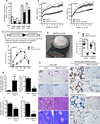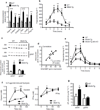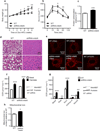MitoNEET-driven alterations in adipocyte mitochondrial activity reveal a crucial adaptive process that preserves insulin sensitivity in obesity
- PMID: 22961109
- PMCID: PMC3745511
- DOI: 10.1038/nm.2899
MitoNEET-driven alterations in adipocyte mitochondrial activity reveal a crucial adaptive process that preserves insulin sensitivity in obesity
Abstract
We examined mouse models with altered adipocyte expression of mitoNEET, a protein residing in the mitochondrial outer membrane, to probe its impact on mitochondrial function and subsequent cellular responses. We found that overexpression of mitoNEET enhances lipid uptake and storage, leading to an expansion of the mass of adipose tissue. Despite the resulting massive obesity, benign aspects of adipose tissue expansion prevail, and insulin sensitivity is preserved. Mechanistically, we also found that mitoNEET inhibits mitochondrial iron transport into the matrix and, because iron is a rate-limiting component for electron transport, lowers the rate of β-oxidation. This effect is associated with a lower mitochondrial membrane potential and lower levels of reactive oxygen species-induced damage, along with increased production of adiponectin. Conversely, a reduction in mitoNEET expression enhances mitochondrial respiratory capacity through enhanced iron content in the matrix, ultimately corresponding to less weight gain on a high-fat diet. However, this reduction in mitoNEET expression also causes heightened oxidative stress and glucose intolerance. Thus, manipulation of mitochondrial function by varying mitoNEET expression markedly affects the dynamics of cellular and whole-body lipid homeostasis.
Figures






Similar articles
-
A Novel Model of Diabetic Complications: Adipocyte Mitochondrial Dysfunction Triggers Massive β-Cell Hyperplasia.Diabetes. 2020 Mar;69(3):313-330. doi: 10.2337/db19-0327. Epub 2019 Dec 27. Diabetes. 2020. PMID: 31882562 Free PMC article.
-
MitoNEET-mediated effects on browning of white adipose tissue.Nat Commun. 2014 May 28;5:3962. doi: 10.1038/ncomms4962. Nat Commun. 2014. PMID: 24865177 Free PMC article.
-
MitoNEET is an iron-containing outer mitochondrial membrane protein that regulates oxidative capacity.Proc Natl Acad Sci U S A. 2007 Mar 27;104(13):5318-23. doi: 10.1073/pnas.0701078104. Epub 2007 Mar 21. Proc Natl Acad Sci U S A. 2007. PMID: 17376863 Free PMC article.
-
Role of energy charge and AMP-activated protein kinase in adipocytes in the control of body fat stores.Int J Obes Relat Metab Disord. 2004 Dec;28 Suppl 4:S38-44. doi: 10.1038/sj.ijo.0802855. Int J Obes Relat Metab Disord. 2004. PMID: 15592485 Review.
-
Stress turns on the heat: Regulation of mitochondrial biogenesis and UCP1 by ROS in adipocytes.Adipocyte. 2017 Jan 2;6(1):56-61. doi: 10.1080/21623945.2016.1273298. Epub 2016 Dec 16. Adipocyte. 2017. PMID: 28452586 Free PMC article. Review.
Cited by
-
Bioenergetics matter to metabolic health-from a fat progenitor view.Cell Stem Cell. 2021 Apr 1;28(4):589-591. doi: 10.1016/j.stem.2021.03.008. Cell Stem Cell. 2021. PMID: 33798417 Free PMC article.
-
The mitochondrial dicarboxylate carrier prevents hepatic lipotoxicity by inhibiting white adipocyte lipolysis.J Hepatol. 2021 Aug;75(2):387-399. doi: 10.1016/j.jhep.2021.03.006. Epub 2021 Mar 18. J Hepatol. 2021. PMID: 33746082 Free PMC article.
-
Myeloid Cell-Specific Lipin-1 Deficiency Stimulates Endocrine Adiponectin-FGF15 Axis and Ameliorates Ethanol-Induced Liver Injury in Mice.Sci Rep. 2016 Sep 26;6:34117. doi: 10.1038/srep34117. Sci Rep. 2016. PMID: 27666676 Free PMC article.
-
Anti-Inflammatory CDGSH Iron-Sulfur Domain 2: A Biomarker of Central Nervous System Insult in Cellular, Animal Models and Patients.Biomedicines. 2022 Mar 27;10(4):777. doi: 10.3390/biomedicines10040777. Biomedicines. 2022. PMID: 35453528 Free PMC article.
-
Contribution of adipogenesis to healthy adipose tissue expansion in obesity.J Clin Invest. 2019 Oct 1;129(10):4022-4031. doi: 10.1172/JCI129191. J Clin Invest. 2019. PMID: 31573549 Free PMC article. Review.
References
-
- Muoio DM, Newgard CB. Obesity-related derangements in metabolic regulation. Annu Rev Biochem. 2006;75:367–401. - PubMed
-
- Lowell BB, Shulman GI. Mitochondrial dysfunction and type 2 diabetes. Science. 2005;307:384–387. - PubMed
-
- Mehta JL, Rasouli N, Sinha AK, Molavi B. Oxidative stress in diabetes: a mechanistic overview of its effects on atherogenesis and myocardial dysfunction. Int J Biochem Cell Biol. 2006;38:794–803. - PubMed
Publication types
MeSH terms
Substances
Associated data
- Actions
Grants and funding
- K99 DK094973/DK/NIDDK NIH HHS/United States
- K99-DK094973/DK/NIDDK NIH HHS/United States
- P01 DK088761/DK/NIDDK NIH HHS/United States
- T32-DK091317/DK/NIDDK NIH HHS/United States
- RC1 DK086629/DK/NIDDK NIH HHS/United States
- R01 DK081842/DK/NIDDK NIH HHS/United States
- R01-DK55758/DK/NIDDK NIH HHS/United States
- T32 DK091317/DK/NIDDK NIH HHS/United States
- RC1-DK086629/DK/NIDDK NIH HHS/United States
- P01-DK088761/DK/NIDDK NIH HHS/United States
- R01-DK081842/DK/NIDDK NIH HHS/United States
- R01 DK055758/DK/NIDDK NIH HHS/United States
LinkOut - more resources
Full Text Sources
Other Literature Sources
Medical
Molecular Biology Databases

